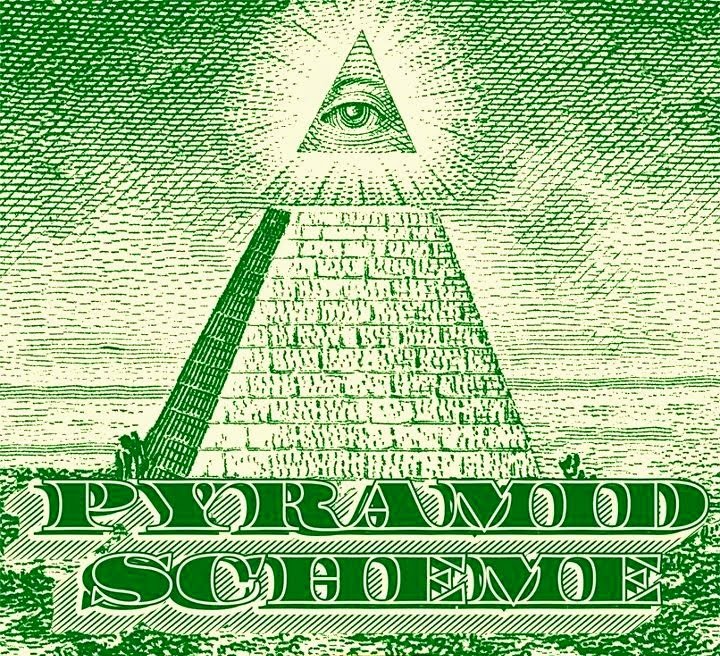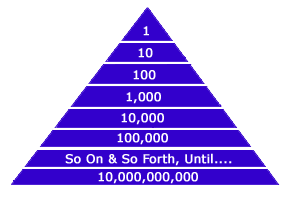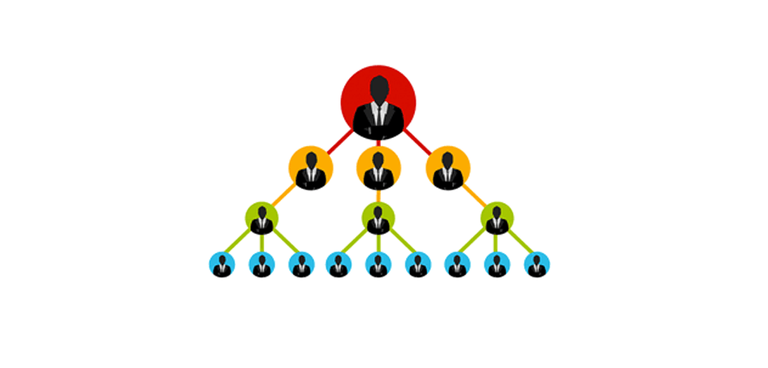What is a Pyramid Scheme
A pyramid scheme is an illegal investment scam based on a hierarchical setup. The most famous kind of pyramid scheme is, perhaps, the Ponzi scheme. New recruits make up the base of the pyramid and provide the funding, or so-called returns, in the form of new money outlays to the earlier investors/recruits structured above them in the scheme. A pyramid scheme does not usually involve the selling of products. Rather, it relies on the constant inflow of money from additional investors that works its way to the top of the pyramid. This means that multilevel marketing schemes are not classified as pyramid schemes and are not necessarily fraudulent.

What Is A Pyramid Scheme?
BREAKING DOWN Pyramid Scheme
An individual or a company initiates a pyramid scheme by recruiting investors with an offer of guaranteed high returns. As the scheme begins, the earliest investors do receive a high rate of return, but these gains are paid for by new recruits and are not a return on any real investment. From the moment the scam is initiated, a pyramid scheme's liabilities begin to exceed its assets. The only way it can generate wealth is by promising extraordinary returns to new recruits; the only way these returns receive payment is by getting additional investors. Invariably these schemes lose steam and the pyramid collapses.

Basic Pyramid Scheme
A pyramid scheme is a variation of the Ponzi scheme, which offers a promise of high investment returns that are not available from traditional types of investment. In practice, the structure of pyramid schemes induces others to recruit victims and collect money that eventually makes its way to the top of the pyramid. In a typical setup, one person recruits a second person to invest a certain amount of money. The second person recovers his investment by recruiting people under him to invest in the scheme. The more people he can recruit under him, the greater his profit, and a certain percentage of the profits of all recruiters work their way up the pyramid to enrich the recruiters before him. Each person must recruit a certain number of people. The process continues until there are fewer people at the bottom of pyramid, and it collapses under its own weight. Generally, only the people near the top of the pyramid make any significant profits, and people near the bottom never recover their investments.
A recent and well-known pyramid scheme involved the fall of Bernie Madoff, who promised and often fulfilled apparently extraordinary investment returns by enlisting new members to part with their money. Madoff has admitted to his crimes and is serving a jail sentence, but only after hundreds of investors collectively lost millions of dollars in the fraud.

Business Pyramids (Multilevel Marketing Schemes)
On their face, multilevel marketing companies are structured like a pyramid. Individuals have the opportunity to invest in their own businesses, which, ostensibly, distribute a product. However, with some companies, the real profit opportunity comes not from selling products but from inducing others into buying into their own business, with a percentage of the investment moving up the hierarchy of recruiters. These companies include the likes of Amway, Rodan + Fields and Tupperware. Among the more high-profile multilevel marketing companies to be investigated as a pyramid scheme is Herbalife Ltd. Herbalife distributors can make money just by selling the company’s products, but they must purchase and sell thousands of dollars' worth of the products before they realize a profit. Critics allege that the company's top recruiters receive the vast majority of profits.
Regulators have determined that a multilevel marketing structure is not fraudulent if the company makes most of its profits from selling products or services to end-user consumers, as opposed to recruiting new sales agents and requiring those agents purchase their own inventory.
Hello,
In order to prevent identity theft, identity deception of all types, and content theft we like to encourage users that have an online identity, post for a website or blog, are creators of art and celebrities of all notoriety to verify themselves. Verified users tend to receive a better reception from the community.
In order to confirm your authorship of the content, please make a mention of Steemit or add a hyperlink to Steemit in your Investopedia profile:
https://www.investopedia.com/contributors/53661/
You can remove this mention from your website, once we confirm the authorship.
Thank you.
More Info: Introducing Identity/Content Verification Reporting & Lookup
Hi! I am a robot. I just upvoted you! I found similar content that readers might be interested in:
https://www.investopedia.com/terms/p/pyramidscheme.asp
10x im one of the authors on investopedia.com
@dilm purchased a 5.97% vote from @promobot on this post.
*If you disagree with the reward or content of this post you can purchase a reversal of this vote by using our curation interface http://promovotes.com
Congratulations @dilm! You have completed the following achievement on the Steem blockchain and have been rewarded with new badge(s) :
You can view your badges on your Steem Board and compare to others on the Steem Ranking
If you no longer want to receive notifications, reply to this comment with the word
STOPVote for @Steemitboard as a witness to get one more award and increased upvotes!
!cheetah ban
Failed Authorship Verification.
Okay, I have banned @dilm.